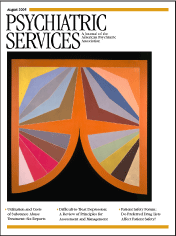Abstract
OBJECTIVE: This study examined whether and how various organizational and environmental forces influence staffing in outpatient substance abuse treatment programs. METHODS: The authors used data from the 1995 and 2000 waves of the National Drug Abuse Treatment System Survey (NDATSS), a telephone survey of unit directors and clinical supervisors. Multivariate analyses with generalized estimating equations were conducted. Two measures of staffing were modeled: the number of weekly treatment hours per client, and active caseload. RESULTS: Managed care activity influenced active caseloads but not the number of treatment hours per client. Significant differences were noted in staffing levels among private for-profit, private nonprofit, and public treatment programs, with public units offering fewer hours per client and having larger caseloads. Units accredited by the Joint Commission on Accreditation of Healthcare Organizations offered more treatment hours per client. CONCLUSIONS: The results of this study contribute to the understanding of various influences on treatment staff time and caseloads. Understanding these relationships is critical for policy makers, managed care companies, and managers, because staffing levels have the potential to affect both the cost and the quality of treatment.



